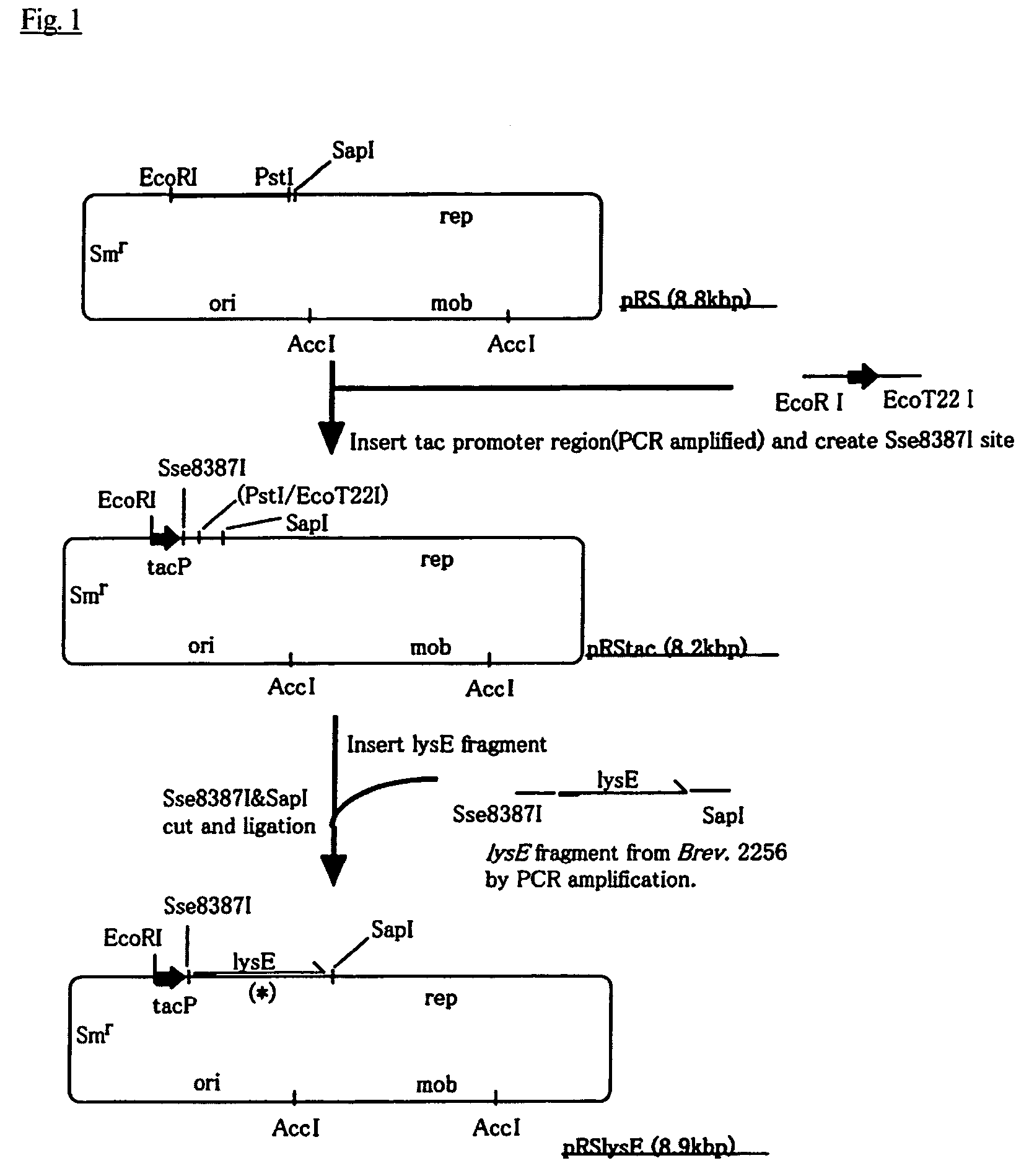Method for producing L-amino acid using methylotroph
a technology of methylotroph and methylotrophin, which is applied in the field of microorganism engineering technique, can solve the problems of no amino acid secretion gene that can exhibit secretion activity in methanol-assimilating bacteria, and no reports to date on improving the production of l-amino acid, so as to improve the productivity of l-lysine and l-arginine, and improve the productivity of methanol-assimilating bacteria
- Summary
- Abstract
- Description
- Claims
- Application Information
AI Technical Summary
Benefits of technology
Problems solved by technology
Method used
Image
Examples
example 1
Construction of Mutant lysE Gene Library
[0092]First, the lysE gene, a homologous gene of the gene enhancing the secretion of L-lysine known for Corynebacterium bacteria, was cloned from a Brevibacterium bacterium, and expression of the gene was attempted in a Methylophilus bacterium.
(1) Construction of pRSlysE
[0093]In order to introduce lysE into a Methylophilus bacterium, a known plasmid pRS (see International Patent Publication in Japanese (Kohyo) No. 3-501682) was used to construct a plasmid pRSlysE for expression of lysE. pRS is a plasmid having the vector segment of the pVIC40 plasmid (International Patent Publication WO90 / 04636, International Patent Publication in Japanese No. 3-501682) and obtained from pVIC40 by deleting a DNA region encoding the threonine operon contained in the plasmid. The plasmid pVIC40 is derived from a broad host spectrum vector plasmid pAYC32 (Chistorerdov, A. Y., Tsygankov, Y. D., Plasmid, 1986, 16, 161-167), which is a derivative of RSF1010.
[0094]Sp...
example 2
Introduction of L-lysine Biosynthesis Enzyme Gene and lysE562, lysE564 or lysE565 Gene into Methylophilus methylotrophus
[0119]Since it was found that the extracellular secretion of L-lysine was enhanced by the introduction of the lysE562, lysE564 or lysE565 genes, an L-lysine biosynthesis was enhanced in a strain introduced with the lysE562, lysE564 or lysE565 gene to attempt further improvement of the productivity.
(1) Construction of Plasmid pRSdapA having dapA* Gene
[0120]A plasmid having a gene encoding dihydrodipicolinate synthase that did not suffer feedback inhibition by L-lysine (dapA*) as an L-lysine biosynthesis system enzyme gene was prepared.
[0121]pRStac prepared in Example 1 was digested with Sse8387I and XbaI and added to a phenol / chloroform solution and mixed to terminate the reaction. After the reaction mixture was centrifuged, the upper layer was collected, and DNAs were collected by ethanol precipitation and separated on a 0.8% agarose gel to collect a DNA fragment ...
example 3
Introduction of lysE564 Gene into Methylobacillus glycogenes and L-amino Acid Production
(1) Preparation of pRS-lysE564-Tc
[0129]It was decided to confirm whether lysE562, lysE564 and lysE565, which contain mutant lysE, function in Methylobacillus bacteria. For this purpose, lysE564 was selected, and pRSlysE564, a plasmid for expression of lysE564, was modified. The pRSlysE564 plasmid carries a streptomycin resistant gene. However, since Methylobacillus glycogenes is originally resistant to streptomycin, the pRSlysE plasmid cannot be screened. Therefore, a modified plasmid was constructed by inserting a tetracycline resistance gene into the pRSlysE plasmid that could be used in Methylobacillus glycogenes.
[0130]First, pRS-lysE564-Tc canying the tetracycline resistance gene was constructed from pRSlysE564. The pRS-lysE564 plasinid was digested with a restriction enzyme EcoRI and added to a phenol / chloroform solution and mixed to terminate the reaction. The reaction mixture was centrifu...
PUM
| Property | Measurement | Unit |
|---|---|---|
| Temperature | aaaaa | aaaaa |
| Length | aaaaa | aaaaa |
| Fraction | aaaaa | aaaaa |
Abstract
Description
Claims
Application Information
 Login to View More
Login to View More - R&D
- Intellectual Property
- Life Sciences
- Materials
- Tech Scout
- Unparalleled Data Quality
- Higher Quality Content
- 60% Fewer Hallucinations
Browse by: Latest US Patents, China's latest patents, Technical Efficacy Thesaurus, Application Domain, Technology Topic, Popular Technical Reports.
© 2025 PatSnap. All rights reserved.Legal|Privacy policy|Modern Slavery Act Transparency Statement|Sitemap|About US| Contact US: help@patsnap.com

